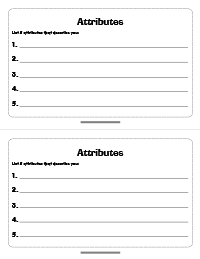The Attributes Game

By far, this is the game my students L-O-V-E the best. That’s because it’s all about them. And that’s okay because I get to use it to help kids make connections in math.
This is a game we used to do in Mathematics A Way of Thinking (Math Their Way) workshops. It’s all about attributes. Attributes are characteristics of something. I actually use the word ‘attributes’ with students because I want them to become familiar with what it means. That way I can connect it later when we study geometry.
The game is super, super easy and can take anywhere from a couple of minutes to a half hour if you let it. But I keep it to a couple of minutes so that we can finish it over several days.
First, your students are going to list 5 attributes about themselves. I tell them that the attributes are things that define who we are…like blue eyes and glasses. It’s important that when they list their attributes, they list things that don’t change from day to day. For example, my blue eyes won’t change the following day. But the red shirt I have on will. So I can’t list my red shirt. To help them understand what I mean, and to give them ideas, I share with them (on the overhead or doc camera) my 5 attributes:
- love to read
- have a rock collection
- enjoy hanging out at the ocean
- have two brothers and two sisters
- like playing board games
I then pass out a half sheet of lined paper for them to write on. This is probably one of the only times they DO NOT write their names at the top. If they do write their name, well, they’re well trained and I just ignore it.
It will take the younger kids a little longer to write their attributes. To help them out a little, I tell them not to write in complete sentences. Again, one of the few times this will happen! When everyone is finished, I collect and shuffle them.
Now the fun begins. Everyone stands up. I randomly choose one of the papers to read from. I don’t have to read the attributes in order. In fact, I usually don’t. If the attribute I read applies to them, they STAY STANDING. If the attribute does not apply to them, they SIT DOWN. I make it very clear that they are responsible for themselves only. If I read ‘have blond hair’ and someone stays standing who they don’t think has blond hair…well, it’s not up to them. It’s a personal and individual decision.
Reading the attributes is a great way for everyone to get to know each other. “Wow, look at how many of you love to swim. You all have this same attribute. Cool.” As the attributes get whittled down, there are less and less students standing. The ultimate goal is to have one student standing all by him- or herself. But it’s okay it that doesn’t happen. In fact, in the beginning, it may not happen much. But just look at all the things the students have in common! And as they get the hang of it, the next time we write attributes, they become more specific.
When I do end up with just one student standing, it’s the perfect time to find out about them. For example, if they listed like to swim, then I may ask a few questions about being on a swim team, where they swim, etc. They LOVE this. Again, it’s all about them.
So that the game lasts awhile, I only read 3-5 students’ lists at a time. I like to do it right before recess or right before the end of school. It’s a fun way to send them off. When I’ve gone through my pile, I pass out new paper and we start again.
So we know why the kids love the game. But I love it because it helps build positive relationships with the students. Those positive relationships build trust. And trust creates a powerful learning environment.
The Math Connection: Attributes appear a lot in geometry. And looking for and describing them helps students organize and make sense of the math they are working on. Once students play the Atrribute game, it’s easy for them to describe the attributes of, say, a rectangle: four right angles and two sets of parallel sides.
And then anytime you sort and classify objects (pre-algebra), you’re looking at attributes.